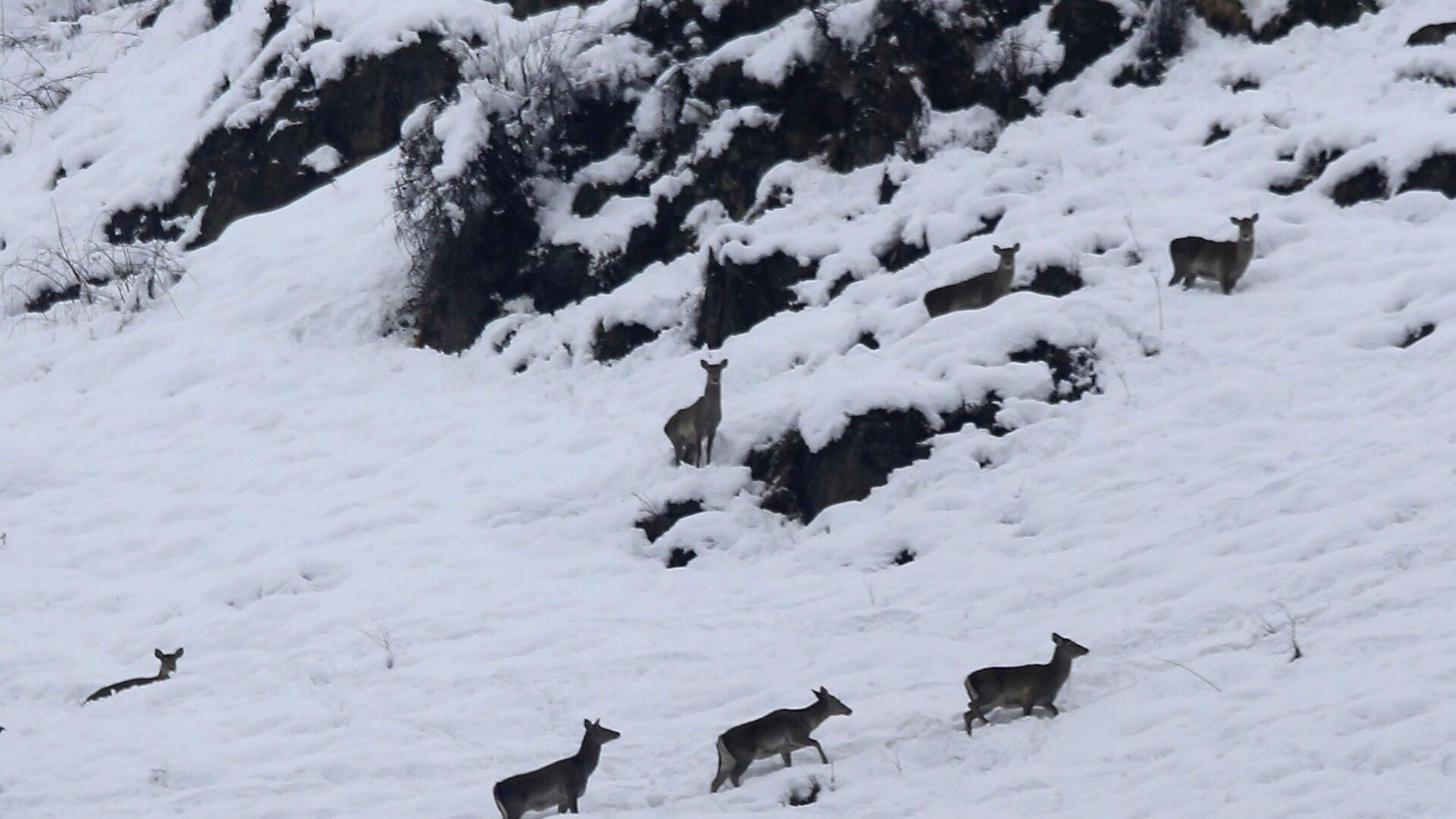https://sputniknews.in/20221226/seventy-three-critically-endangered-species-to-get-extra-protection-in-india-253639.html
Seventy-Three 'Critically Endangered' Species to Get Extra Protection in India
Seventy-Three 'Critically Endangered' Species to Get Extra Protection in India
Sputnik India
Among those in grave danger are the Kashmir Stag/Hangul, Malabar Large-Spotted Civet, Andaman Shrew, Jenkin’s Shrew, Nicobar Shrew, Namdhapa Flying Squirrel... 26.12.2022, Sputnik India
2022-12-26T19:16+0530
2022-12-26T19:16+0530
2022-12-26T19:17+0530
political affairs
india
environment
nature conservation
endangered species
https://cdn1.img.sputniknews.in/img/07e6/0c/1a/255211_0:160:3073:1888_1920x0_80_0_0_e53963a84984f02fb40def2ab946e1dc.jpg
From 47 in 2011 to 73 today, India is seeing a drastic increase in “critically endangered” wildlife species considered to be facing an extremely high risk of extinction, according to the International Union for Conservation of Nature.To provide the highest level of protection to the endangered species, Minister for Environment, Forest, and Climate Change Ashwini Kumar Choubey told the Rajya Sabha (upper house of parliament) that the government is now considering the inclusion of endangered species in the Schedule-I of Wildlife (Protection) Act, 1972.The act will provide rigorous protection and the harshest penalties for hunting and violating the laws.What is the Primary Challenge?The decision came after Congress Party MP Mukul Wasnik raised the alarm about the drastic decline of the species in the country and asked about the government's plans for the protection and conservation of critically endangered species.In response, the Ministry of Environment, Forest and Climate Change (MoEFCC) proposed that endangered species be included in various appendices of the Convention on International Trade in Endangered Species of Wild Fauna and Flora (CITES) to curb trafficking.Out of the nine mammal species that are on the verge of extinction, eight are endemic due to limited habitat in India. These include the Kashmir Stag/Hangul, Malabar Large-Spotted Civet, Andaman Shrew, Jenkin’s Shrew, Nicobar Shrew, Namdhapa Flying Squirrel, Large Rock Rat and Leafletted Leaf-nosed Bat.Out of 26 endangered reptiles, five are endemic to India, including the Island Pit Viper whose habitat is limited to a single location on the Car Nicobar Island.The 18 critically endangered bird species include Baer’s Pochard, Great Indian Bustard, Sociable Lapwing, Red-headed Vulture, White-Rumped Vulture, Indian Vulture and Slender-billed Vulture.Out of 20 endangered amphibians, several species are limited to habitats in the Western Ghats, the northeast, and Andaman and Nicobar Islands.In one example, the Charles Darwin Frog in Andaman and Nicobar Island lives in an area less than 100 square km. While its distribution is severely fragmented, there is a continuing decline in the area.Another species, the Dattatreya Night Frog, lives in less than 30 square km in a single location.Delhi and the Department of Science and Technology have been keeping a track of these species through various research projects.
https://sputniknews.in/20221213/over-90-of-marine-species-uncategorized-may-go-extinct-scientists-at-cop15-22010.html
india
Sputnik India
feedback.hindi@sputniknews.com
+74956456601
MIA „Rossiya Segodnya“
2022
Sangeeta Yadav
https://cdn1.img.sputniknews.in/img/07e6/0c/0f/110602_0:0:641:640_100x100_80_0_0_c298016a79eb02ef8caa9d1f688c12a5.jpg
Sangeeta Yadav
https://cdn1.img.sputniknews.in/img/07e6/0c/0f/110602_0:0:641:640_100x100_80_0_0_c298016a79eb02ef8caa9d1f688c12a5.jpg
News
en_IN
Sputnik India
feedback.hindi@sputniknews.com
+74956456601
MIA „Rossiya Segodnya“
Sputnik India
feedback.hindi@sputniknews.com
+74956456601
MIA „Rossiya Segodnya“
Sangeeta Yadav
https://cdn1.img.sputniknews.in/img/07e6/0c/0f/110602_0:0:641:640_100x100_80_0_0_c298016a79eb02ef8caa9d1f688c12a5.jpg
nature conservation india, indian endangered species, inida wildlife, species “critically endangered”, international union for conservation of nature (iucn), species facing extremely high risk of extinction in the wild, protection to endangered species, indian government monitoring endangered species, nine mammal species endangered, 18 birds endangered, 26 reptiles endangered, 20 amphibians endangered
nature conservation india, indian endangered species, inida wildlife, species “critically endangered”, international union for conservation of nature (iucn), species facing extremely high risk of extinction in the wild, protection to endangered species, indian government monitoring endangered species, nine mammal species endangered, 18 birds endangered, 26 reptiles endangered, 20 amphibians endangered
Seventy-Three 'Critically Endangered' Species to Get Extra Protection in India
19:16 26.12.2022 (Updated: 19:17 26.12.2022) Among those in grave danger are the Kashmir Stag/Hangul, Malabar Large-Spotted Civet, Andaman Shrew, Jenkin’s Shrew, Nicobar Shrew, Namdhapa Flying Squirrel, Large Rock Rat and Leafletted Leaf-nosed Bat.
From 47 in 2011 to 73 today, India is seeing a drastic increase in “critically endangered” wildlife species considered to be facing an extremely high risk of extinction, according to the International Union for Conservation of Nature.
To provide the highest level of protection to the endangered species, Minister for Environment, Forest, and Climate Change Ashwini Kumar Choubey told the Rajya Sabha (upper house of parliament) that the government is now considering the inclusion of endangered species in the Schedule-I of Wildlife (Protection) Act, 1972.
The act will provide rigorous protection and the harshest penalties for hunting and violating the laws.
What is the Primary Challenge?
The decision came after Congress Party MP Mukul Wasnik raised the alarm about the drastic decline of the species in the country and asked about the government's plans for the protection and conservation of critically endangered species.
In response, the Ministry of Environment, Forest and Climate Change (MoEFCC) proposed that endangered species be included in various appendices of the Convention on International Trade in Endangered Species of Wild Fauna and Flora (CITES) to curb trafficking.
The task is challenging primarily because India's high-priority biodiversity and conservation areas lie outside its existing protected network.
Out of the nine mammal species that are on the verge of extinction, eight are endemic due to limited habitat in India. These include the Kashmir Stag/Hangul, Malabar Large-Spotted Civet, Andaman Shrew, Jenkin’s Shrew, Nicobar Shrew, Namdhapa Flying Squirrel, Large Rock Rat and Leafletted Leaf-nosed Bat.
Out of 26 endangered reptiles, five are endemic to India, including the Island Pit Viper whose habitat is limited to a single location on the Car Nicobar Island.
The 18 critically endangered bird species include Baer’s Pochard, Great Indian Bustard, Sociable Lapwing, Red-headed Vulture, White-Rumped Vulture, Indian Vulture and Slender-billed Vulture.
Out of 20 endangered amphibians, several species are limited to habitats in the Western Ghats, the northeast, and Andaman and Nicobar Islands.
In one example, the Charles Darwin Frog in Andaman and Nicobar Island lives in an area less than 100 square km. While its distribution is severely fragmented, there is a continuing decline in the area.
Another species, the Dattatreya Night Frog, lives in less than 30 square km in a single location.
Delhi and the Department of Science and Technology have been keeping a track of these species through various research projects.
The study to forage the behavior of the White-bellied Heron, which number less than 60 and are found only in Arunachal Pradesh and Assam states, is a subject of research in Namdapha Tiger Reserve.



